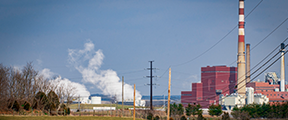Progress Report
Power Sector Programs - Progress Report
The Power Sector Programs Progress Report provides annual updates on EPA’s regulatory programs to reduce emissions in the power sector. Click one of the sections below to get started.
Progress Report Fact Sheet (pdf)
See the index of graphics in this report.
Under the Clean Air Act, EPA implements regulations to reduce emissions from power plants, including the Acid Rain Program (ARP), the Cross-State Air Pollution Rule (CSAPR), the CSAPR Update, the Revised CSAPR Update, and the Mercury and Air Toxics Standards (MATS). These programs require fossil fuel-fired electric generating units to reduce emissions of sulfur dioxide (SO2), nitrogen oxides (NOX), and hazardous air pollutants including mercury (Hg) to protect human health and the environment. This reporting year marks the seventh year of CSAPR implementation, the fifth year of the CSAPR Update implementation, the first year of Revised CSAPR Update implementation, the twenty-seventh year of the ARP, and the fifth year of MATS implementation. This report summarizes annual progress, highlighting data that EPA systematically collects on emissions for all power plant programs and on compliance for the ARP and the CSAPR programs. Commitment to transparency and data availability is a hallmark of these programs and a cornerstone of their success.
SO2, NOX, and hazardous air pollutants (HAPs), including mercury, are fossil fuel combustion byproducts that affect public health and the environment. SO2 and NOX, and their sulfate and nitrate byproducts, are transported downwind and deposited as acid rain which can be harmful to sensitive ecosystems in many areas of the country. These pollutants also contribute to the formation of fine particles (sulfates and nitrates) and ground-level ozone that are associated with significant human health effects and regional haze. Atmospheric mercury deposition accumulates in fish to levels of concern for human health and the health of fish-eating wildlife.
The ARP, CSAPR, CSAPR Update, Revised CSAPR Update, and MATS have delivered substantial reductions in power sector emissions of SO2, NOX, and hazardous air pollutants, along with significant improvements in air quality and the environment. In addition to the requirement of the power sector emission control programs described in this report, a variety of power industry trends have contributed to further declines of SO2, NOX, and hazardous air pollutant emissions.








